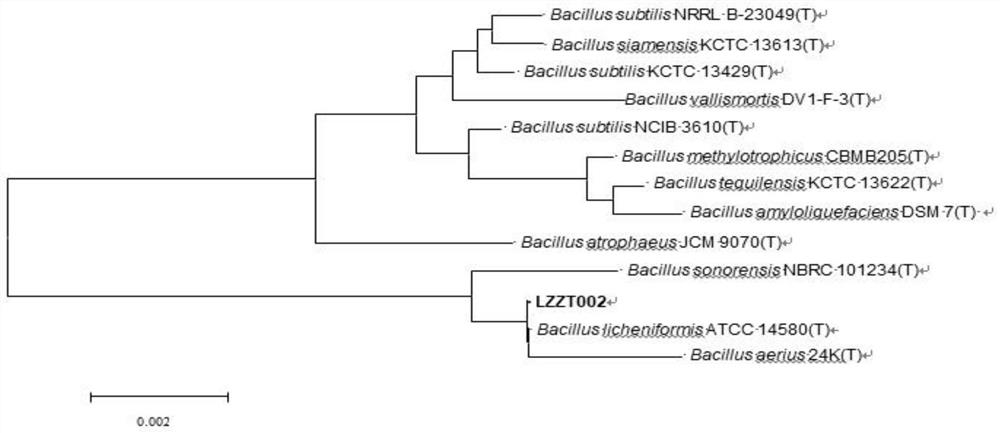A strain of Bacillus licheniformis and its application
A technology of Bacillus licheniformis and strains, applied in application, bacteria, microorganisms and other directions, can solve problems such as affecting application, poor water solubility or stability, and low efficacy, achieve good economic and social benefits, and improve disease resistance. Ability, health-enhancing effect
- Summary
- Abstract
- Description
- Claims
- Application Information
AI Technical Summary
Problems solved by technology
Method used
Image
Examples
Embodiment 1
[0020] Example 1 Isolation and identification of Bacillus licheniformis LZZT-002
[0021] The soil samples of Astragalus root were collected, and the microbial strains were isolated and purified by the dilution plate method. Using culture characteristics and morphological observation to pick out multiple microbial strains, and identify the strains by Gram staining method and 16s rRNA gene rapid amplification and sequencing method. The 16s rRNA gene was identified using the strain DNA as the template, and its 16S rDNA sequence was amplified by PCR. The primers were (27f): 5'-AGAGTTTGATCCTGGCTCAG-3', SEQ ID NO. 1; and (1492r): 5'-GGTTACCTTGTTACGACTT-3', SEQ ID NO. 2. The PCR reaction program was: pre-denaturation at 95°C for 6 minutes, denaturation at 95°C for 30 seconds, annealing at 53°C for 30 seconds, extension at 72°C for 70 seconds, 30 cycles. The amplified product was sequenced after its purity was checked by electrophoresis. The obtained 16S rRNA gene sequences were co...
Embodiment 2
[0022] Example 2 Detection of xylanase activity of strain LZZT-002
[0023] After the LZZT-002 strain was fermented for two days in liquid medium (tryptone 5g, oat xylan 5g, glucose 5g, sodium chloride 5g, distilled water 1000ml, pH7.2), the cells were collected by centrifugation and placed in PBS buffer , use an ultrasonic disruptor at a power of 600W to disrupt the cells, and then centrifuge to obtain the supernatant, that is, to obtain the crude enzyme solution.
[0024] The detection of xylanase activity refers to the national standard (GB / T 23874-2009).
[0025] Standard curve preparation: draw 4ml of 0.1M acetic acid-sodium acetate buffer (pH5.5), add 5.0ml of DNS reagent, heat in a boiling water bath for 5 minutes, cool to room temperature, add water to make up to 25ml, and prepare a standard blank. Xylan standards were prepared at 0.1 mg / ml, 0.2 mg / ml, 0.3 mg / ml, 0.4 mg / ml, 0.5 mg / ml, 0.6 mg / ml and 0.7 mg / ml. Take 2ml of each standard solution, add 2ml of 0.1M acetic...
Embodiment 3
[0029] Example 3 Detection of cellulase activity of strain LZZT-002
[0030] Strain LZZT002 was seeded on sodium carboxymethylcellulose medium and cultured for 48 hours. Stained with 0.2% Congo red for 30 minutes, then washed with distilled water to remove the dye, then soaked in 1 mol / L NaCl for 1 hour, and finally fixed the color with 5% (w / v) acetic acid. The formation of a colorless transparent circle around the colony proved that the bacteria secreted cellulase.
PUM
 Login to View More
Login to View More Abstract
Description
Claims
Application Information
 Login to View More
Login to View More - R&D
- Intellectual Property
- Life Sciences
- Materials
- Tech Scout
- Unparalleled Data Quality
- Higher Quality Content
- 60% Fewer Hallucinations
Browse by: Latest US Patents, China's latest patents, Technical Efficacy Thesaurus, Application Domain, Technology Topic, Popular Technical Reports.
© 2025 PatSnap. All rights reserved.Legal|Privacy policy|Modern Slavery Act Transparency Statement|Sitemap|About US| Contact US: help@patsnap.com



